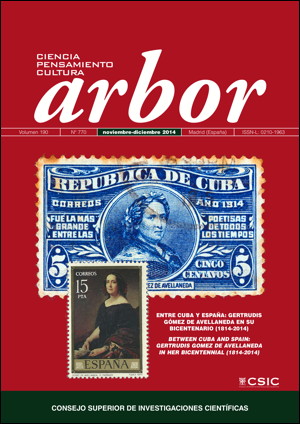Love, destiny and virtue: Gertudis Gómez de Avellaneda and her first drama Leoncia
DOI:
https://doi.org/10.3989/arbor.2014.770n6008Keywords:
Gómez de Avellaneda, romantic drama, love, destiny, virtue, patriarchy, subalternity, feminismAbstract
The success of the romantic drama Leoncia marks the beginning of Gertrudis Gómez de Avellaneda’s career in the theatre. Literary critics have seen in this work two great romantic topics, love and destiny. This essay argues that the author uses romantic rhetoric to address the issue of virtue and of its manipulation within a hierarchical structure of subordination in a patriarchal society. This concern with the concept of virtue permeates much of the work of this Spanish-Cuban author, and is part of her pioneering efforts to expose the problem of women’s subordinate role in the social hierarchy in nineteenth-century Spain.
Downloads
References
Bolufer Peruga, M. (2011). 'Hombres de bien': modelos de masculinidad y expectativas femeninas, entre la ficción y la realidad. Cuadernos de Ilustración y Romanticismo, 15, pp. 7-31.
Cantizano Márquez, B. (2004). La mujer en la prensa femenina del XIX. Ambitos: Revista internacional de comunicación, 11, p.15.
Cotarelo y Mori, E. (1930). La Avellaneda y sus obras: ensayo biográfico y crítico. Madrid: Tipografía de Archivos.
Espronceda, J. (1978). El estudiante de Salamanca; El diablo mundo. Madrid: Castalia.
Gies, D. (1996). El teatro en la España del siglo XIX. Cambridge: Cambridge University Press.
Gómez de Avellaneda, G. (1917). Leoncia. Madrid: Tipografía de la Revista de Archivos, Bibliotecas y Museos.
Gómez de Avellaneda, G. (1990). Obra selecta. Caracas: Biblioteca Ayacucho.
Gómez de Avellaneda, G. (1999). Autobiografía y epistolarios de amor. Newark: Juan de la Cuesta.
Gómez de Avellaneda (2001). Sab. Manchester: Manchester University Press.
Guerra, L. (1985). Estrategias femeninas en la elaboración del sujeto romántico en la obra de Gertrudis Gómez de Avellaneda. Revista iberoamericana, LI, 132-133, pp. 707-722. http://dx.doi.org/10.5195/reviberoamer.1985.4094
Isaacs, J. (1894). María: novela americana. París: Librería Garnier hermanos.
Jagoe, C. (1998). La misión de la mujer. En: Jagoe, C. (ed.). La mujer en los discursos de género: textos y contextos en el siglo XIX. Barcelona: Icaria, pp. 21-53.
Kirkpatrick, S. (1991). Las románticas: escritoras y subjetividad en España, 1835-1850. Madrid: Cátedra.
Martínez Díez, F. (1991). Domingo de Guzmán: evangelio viviente. Salamanca: San Esteban.
Palencia Villa, R. M. (2008). Recuperar el propio cuerpo: discursos fílmicos de resistencia. En: Clúa Ginés, I., Pitarch, P. (eds.). Pasen y vean. Estudios culturales. Barcelona: Universitat Oberta de Catalunya, pp. 41-46.
Piñeyro, E. (1904). Gertrudis Gómez de Avellaneda. Bulletin Hispanique, 6, 2, pp. 143-156. http://dx.doi.org/10.3406/hispa.1904.1403
Prado Mas, M. (2004). El teatro de Gertrudis Gómez de Avellaneda. [Tesis doctoral]. Universidad Complutense de Madrid: Madrid. Recuperado de http://eprints.ucm.es/tesis/fll/ucm-t25107.pdf
Rousseau, J.J (1997). Emilio o de la educación. Madrid: Alianza.
Selimov, A. (1999). La verdad vence apariencias: hacia la ética de Gertrudis Gómez de Avellaneda a través de su prosa. Hispanic review, 67, 2, pp. 215-241. http://dx.doi.org/10.2307/474915 http://dx.doi.org/10.2307/474915
Sommer, D. (1988). Sab c'est moi. Genders, 2, pp. 111-126.
Torres-Pou, J. (1993). La ambigu.edad del mensaje feminista de 'Sab' de Gertrudis Gómez de Avellaneda. Letras Femeninas, 19, 1/2, pp. 55-64.
Published
How to Cite
Issue
Section
License
Copyright (c) 2014 Consejo Superior de Investigaciones Científicas (CSIC)

This work is licensed under a Creative Commons Attribution 4.0 International License.
© CSIC. Manuscripts published in both the printed and online versions of this Journal are the property of Consejo Superior de Investigaciones Científicas, and quoting this source is a requirement for any partial or full reproduction.
All contents of this electronic edition, except where otherwise noted, are distributed under a “Creative Commons Attribution 4.0 International” (CC BY 4.0) License. You may read the basic information and the legal text of the license. The indication of the CC BY 4.0 License must be expressly stated in this way when necessary.
Self-archiving in repositories, personal webpages or similar, of any version other than the published by the Editor, is not allowed.














